5 Senior Golf Swing Tips for a Quick Win
You’ve Never Heard These 5 Senior Golf Swing Tips Before. Once You Learn Them, Your Game Will Never Be the Same.
Looking for a quick win in your golf game?
I’ve got you covered with my five senior golf swing tips.
After 30 years of coaching, I can honestly say these are the most important concepts for “experienced” golfers to understand. If you incorporate these strategies into your game, you’ll see more distance and better contact than you thought was even possible at this point in your life.
And they couldn’t be easier to execute. Learn them today, use them on the course tomorrow. It’s that simple.
Ready to make surprisingly swift progress?
Let’s get to it.
Senior Golf Swing Tips: Key Points
Here’s the super-short version of everything we’re about to cover:
- Lengthen your swing by bringing your lead arm straight back and up on the backswing.
- Flare your toes for more balance and easier rotation.
- Avoid the dreaded sway by loading weight onto the inside of the trail foot when you swing back.
- Make sure your knees are touching when you finish your swing.
- Relax your arms and allow them to generate clubhead speed instead of relying on techniques your body can’t pull off anymore.
My Top Five Senior Golf Swing Tips
There’s a reason your old tried-and-true swing tricks have stopped working for you.
It’s because traditional golf instruction is based on what works for tour professionals. Their strategies won’t always get results for us mortals, especially when we start losing flexibility, strength, and balance.
My top five senior golf swing tips are all designed to meet your body where it is. Put these into action, and you’ll start getting more distance without the strain and more accuracy without the mind-bending calculations.
Let’s count ‘em down.
Tip #5: Bring Your Lead Arm Straight Back and Up in the Backswing
This one is huge. So huge, I developed an entire golf system around it and then wrote a bestselling book based on that system.
If you’ve been trying to power your golf shots with a flat backswing, it’s time to stop. It’s a real distance killer. The only way to lengthen a swing that goes around your body is to rotate deeper. And as an experienced golfer, you simply don’t have the range of motion anymore.
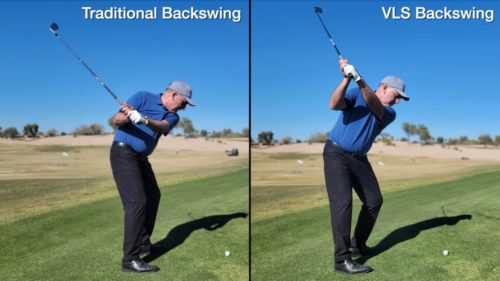
Instead, you want to think about bringing the lead up straight back and up on the backswing, creating a more vertical swing path. Here’s an easy way to find the sweet spot:
- Take your regular golf setup.
- Lift the club out in front of you so your hands are as high as the buttons on your golf shirt.
- Rotate back like you would on your backswing.
- Notice where your hands are. That’s where you want them when you reach the top of your backswing.
Tip #4: Flare Your Toes
Try something for me real quick.
Stand up and assume your regular golf stance, with your toes pointing straight ahead. Rotate like you would for your golf swing, noticing how far you’re able to turn.
Now flare your toes out. Rotate again. You can turn farther from this position, can’t you?
This is an easy, pain-free strategy for recovering your lost range of motion. Some of it, anyway.
And as we know, that deeper turn is going to lengthen your backswing and boost your distance. It’s also going to make you feel more stable in your stance, and it’s a great way to improve your rhythm, tempo, and contact. Wins all around.
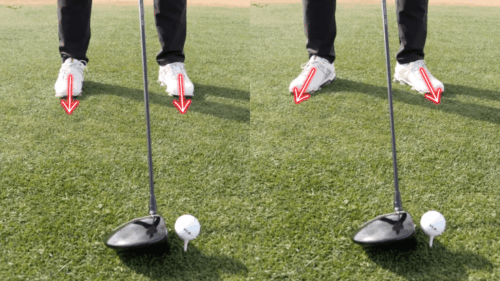
As for how much you should flare your toes, it’s really up to you. I’d say 20-30° is a good starting point, but feel free to experiment with it. See what feels natural for you and gets you the rotation you need.
Tip #3: Load, Don’t Sway
If you know me at all, you know I’m all about the 60/40.
That’s the concept that you want to set up with 60% of your weight on the lead foot and 40% on the trail foot, shift the majority of your weight to the trail foot as you swing back, and finally shift it forward again on the downswing.
This is called loading. You’re loading weight and energy into your trail foot on the backswing, ramping up to send that energy forward and into the ball on the downswing.
This is huge for senior golfers because that lateral motion allows you to generate more clubhead speed without relying on raw power or deep rotation.
The problem is that a lot of experienced golfers don’t load. They sway. That knocks them off balance and compromises their contact.
The sway happens when you shift your weight from the lead foot to the outside of the trail foot.
In order to load, you need to shift that weight to the inside of the trail foot. It’s a small distinction that makes a huge difference.
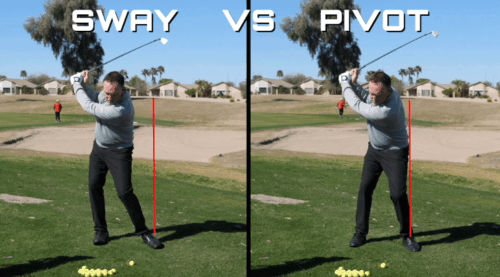
So how do you know if you’re loading properly?
Your knees will tell you.
Let’s say you’ve got about 30° of bend in your knees at setup. (I’m just using that measurement as an example; don’t worry about the exact degree of your bend.) On the backswing, your trail knee should straighten to about 15° as the bend in your lead knee deepens. If you’re doing that, you know you’re shifting weight to the inside of your trail foot.
Tip #2: Get Your Knees Touching at the Finish
Make sure you finish your swing with your knees touching. That’s it. Easiest tip on the list.
This is something you can only pull off by unloading—shifting the weight in your trail foot back to the lead foot on the downswing. That helps you move energy toward the target and put more power into the golf ball.
Older golfers often develop a habit of keeping their weight on the trail foot as they swing forward. It’s an instinctual thing. Their balance isn’t what it used to be, and they unconsciously try to get some stability by steadying themselves on their trail leg.
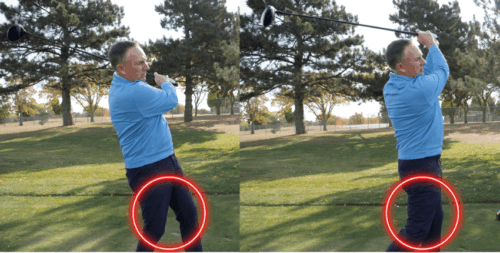
But you’re already set up with a nice solid stance, toes flared, and a good sense of how to shift weight without swaying. Just focus on getting those knees touching, and you’ll find that you feel perfectly steady with the weight transfer.
Proper unloading doesn’t just help you pick up more yards. It helps you stop hitting behind the golf ball and cures several contact disasters, including the dreaded slice.
Tip #1: Use Your Arms Correctly
When we’re young, we can rely on things like muscle and deep rotation to generate clubhead speed. As we age, however, we find that these techniques are less reliable.
The good news is that you can still get a ton of speed out of your arms well into your retirement years. You just have to know how.
Here’s a drill I use with my students to help them tap into this speed source before a shot:
- Stand back from the golf ball with your feet together.
- Take several continuous practice swings, focusing less on your form and more on allowing the arms to relax and swing freely.
- Step up to the ball and hit a shot.
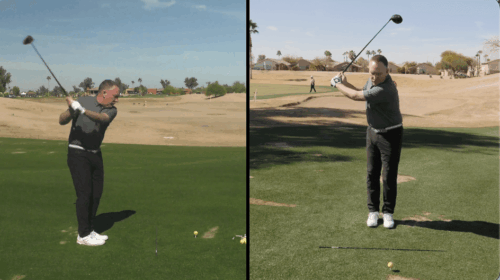
Try this a few times, and I think you’ll be shocked by the momentum you unlock.
Next Steps for Mastering Your Senior Golf Swing
These five tips are great for a quick win. But if you’re serious about improving your senior golf swing, I highly recommend working directly with my team and me at VLS Coaching. Through our programs, you get access to personalized, world-class instruction without the hefty price tag.
And if you have any questions after reading this article, jump into the comments below and let me know! I’m always happy to help any way I can.
About the Author
I’m PGA Teaching Professional Todd Kolb—a four-time Golf Digest Best-in-State Instructor, Amazon Best-selling Author, and Minnesota PGA Teacher of the Year. I’ve worked with students of all ages and skill levels in my 30 years of coaching, from first-timers to an LPGA major champion. I’m also the Director of Instruction for VLS Golf and USGolfTV.
My work with VLS Golf and USGolfTV revolves around helping the everyday golfer cut through overcomplicated traditional instruction to find solutions that actually work for them.
 |
|
